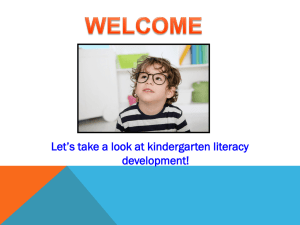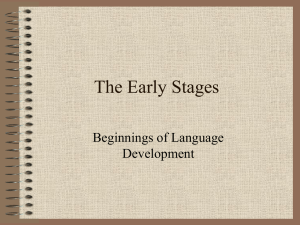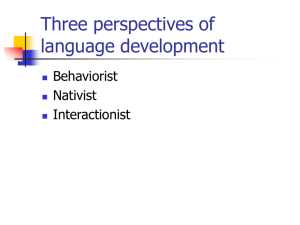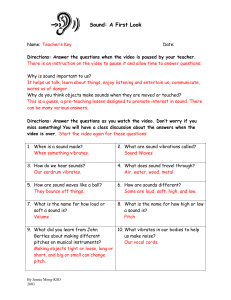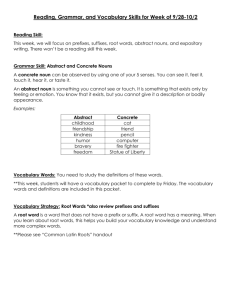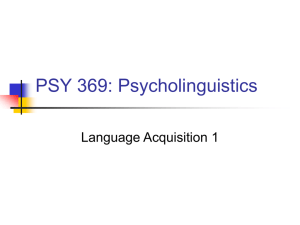Child Language Development Stages & Theories
advertisement
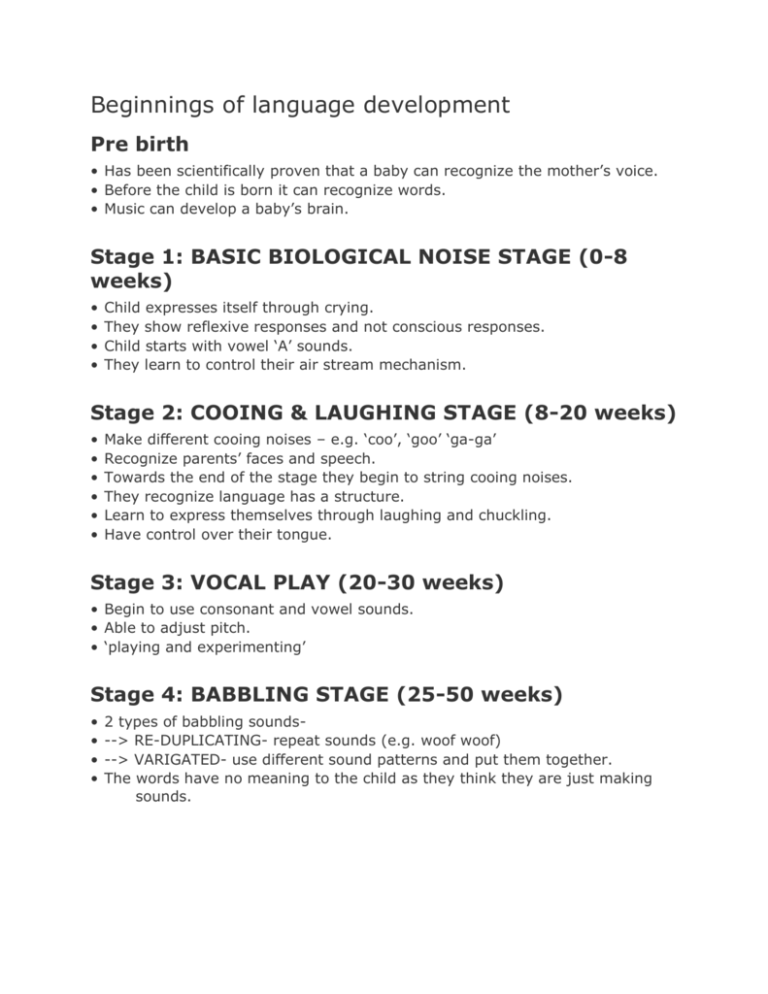
Beginnings of language development Pre birth • Has been scientifically proven that a baby can recognize the mother’s voice. • Before the child is born it can recognize words. • Music can develop a baby’s brain. Stage 1: BASIC BIOLOGICAL NOISE STAGE (0-8 weeks) • • • • Child expresses itself through crying. They show reflexive responses and not conscious responses. Child starts with vowel ‘A’ sounds. They learn to control their air stream mechanism. Stage 2: COOING & LAUGHING STAGE (8-20 weeks) • • • • • • Make different cooing noises – e.g. ‘coo’, ‘goo’ ‘ga-ga’ Recognize parents’ faces and speech. Towards the end of the stage they begin to string cooing noises. They recognize language has a structure. Learn to express themselves through laughing and chuckling. Have control over their tongue. Stage 3: VOCAL PLAY (20-30 weeks) • Begin to use consonant and vowel sounds. • Able to adjust pitch. • ‘playing and experimenting’ Stage 4: BABBLING STAGE (25-50 weeks) • • • • 2 types of babbling sounds--> RE-DUPLICATING- repeat sounds (e.g. woof woof) --> VARIGATED- use different sound patterns and put them together. The words have no meaning to the child as they think they are just making sounds. Stage 5: MELODIC UTTERANCE STAGE (10-13 months) • A variation in rhythm, melody and tone is shown • The child begins to see some meaning to what they say. • Proto words used- when the child doesn’t say words it recognizes but realizes that words are parts of a sound. AGE 12-18 MONTHS • • • • • • • ◦ ◦ • ◦ • • Developments occur rapidly. Intonations used to show feelings and purpose. Children begin to develop at different levels. Single word utterances – concrete nouns Holophrastic phrases – couple of words put together which have no grammatical concept Child learns about 10-20 words each month. Over extension – when child uses one word to describe lots of things. no concept of differentiating e.g. 4 legged object = dog Under extension - have yet to acquire the knowledge that there are many numbers of the same thing in the world ( e.g. lots of cars in world) have yet to acquire the concept of concrete nouns. Mismatch – get the name of something wrong (e.g. car = doll) Begin to use modifiers so add extra words in front of another word (e.g. go sleep) AGE 18-24 MONTHS • Have a vocabulary of 200 words – shows how quickly they are learning. • Pronunciation - some syllables dropped (e.g. tomato = mato) ◦ Consonant clusters avoided i.e. sky - guy ◦ Re-duplicate sounds- e.g. baby = baybay ◦ no consistency of speaking Pragmatic development The functions of children’ language • Michael Halliday, 1978 – suggested 7 stages that show the functions of a child's language. Stage 1: INSTRUMENTAL STAGE • Language is used to fulfill the child's needs • First words are mainly concrete nouns • Concerned with obtaining food, drink, comfort, etc. Stage 2: REGULATORY STAGE • Language is used to influence the behavior of others • Persuading, commanding, requesting other people to do as they want Stage 3: INTERACTIONAL STAGE • Language is used to develop social relationships and ease interaction • Phatic dimension of talk • E.g. love you, daddy, thank you, Stage 4: PERSONAL STAGE • Language is used to express personal preferences/speaker's identity • Conveys attitudes and expresses feelings • E.g. me good girl Stage 5: INFORMATIVE STAGE • Used to communicate information • Mainly to relay or request information Stage 6: HEURISTIC STAGE • Used to learn and explore the environment • May be questions and answers or running commentary on child's actions Stage 7: IMAGINATIVE STAGE • Used to explore the imagination • Often accompanies play or other leisure activities Theories of language acquisition Theory 1: THE IMITATION THEORY • Theory suggests children learn language through copying and imitating others. Positives • Imitation is important in phonological development. • Children develop regional accents suggesting they imitate the sounds from people around them. Negatives • Children don’t pick up grammatical structures immediately as some children show an incorrect use of grammar. For example they may say ‘wented’ instead of went. Showing they have not imitated this of others. • Kids normally only use the words they understand so if they imitate of others they would copy all words spoken by another person. • If the kid is deaf, it cannot copy another person therefore uses sign language suggesting this theory does not provide an account for all kids. Theory 2: INNATENESS THEORY • Ability to learn is innate, children posses it from birth • Chomsky suggested everyone is born with a special brain mechanism, the language acquisition device or LAD. • The LAD doesn't allow children to simply understand all of the language straight away, but requires stimulus • It enables a child to recognize basic structure and rules surrounding language Theory 3: COGNITIVE THEORY • Suggested by the theorist Jean Piaget • Language is acquired because it is necessary • Children need or want to describe their environment and express their feelings Theory 4: INPUT THEORY • This theory focuses on the language used by the parents. • Motherese, parentese, caretaker language. • The theory stresses that it is important to focus on the person who helps teach the children to speak. Features: • The speed of speech is greatly decreased • • • • Variation in pitch/intonation Parent encourages speech through the use of questions Parent frames sentences in order to help the child. Parents interaction with child helps them to understand the concepts of turn taking, adjacency pairs etc. Basic summary of the features a parent uses when talking to their child Phonology • Slower, clearer pronunciation • More pauses, especially between phrases and sentences. – help introduce the child to the rules of conversation. • Higher pitch. – Makes a child pay attention and listen carefully. • Exaggerated intonation and stress. ^^^ Lexis • Simpler, more restricted vocabulary. – makes language more accessible for child • Diminutive forms used (e.g. doggie) • Concrete language, referring to objects in the child’s environment Grammar • Simpler constructions. • Frequent use of imperatives. • High degree of repetition. – Child is able to understand the meaning of words as parents make the child pay attention to the object by repeating the word. • Frequent use of questions. – Increases the child’s understanding of auxiliary verbs • Use of personal names instead of pronouns (e.g ‘mummy will take you shopping’ instead of ‘I will take you shopping’.
